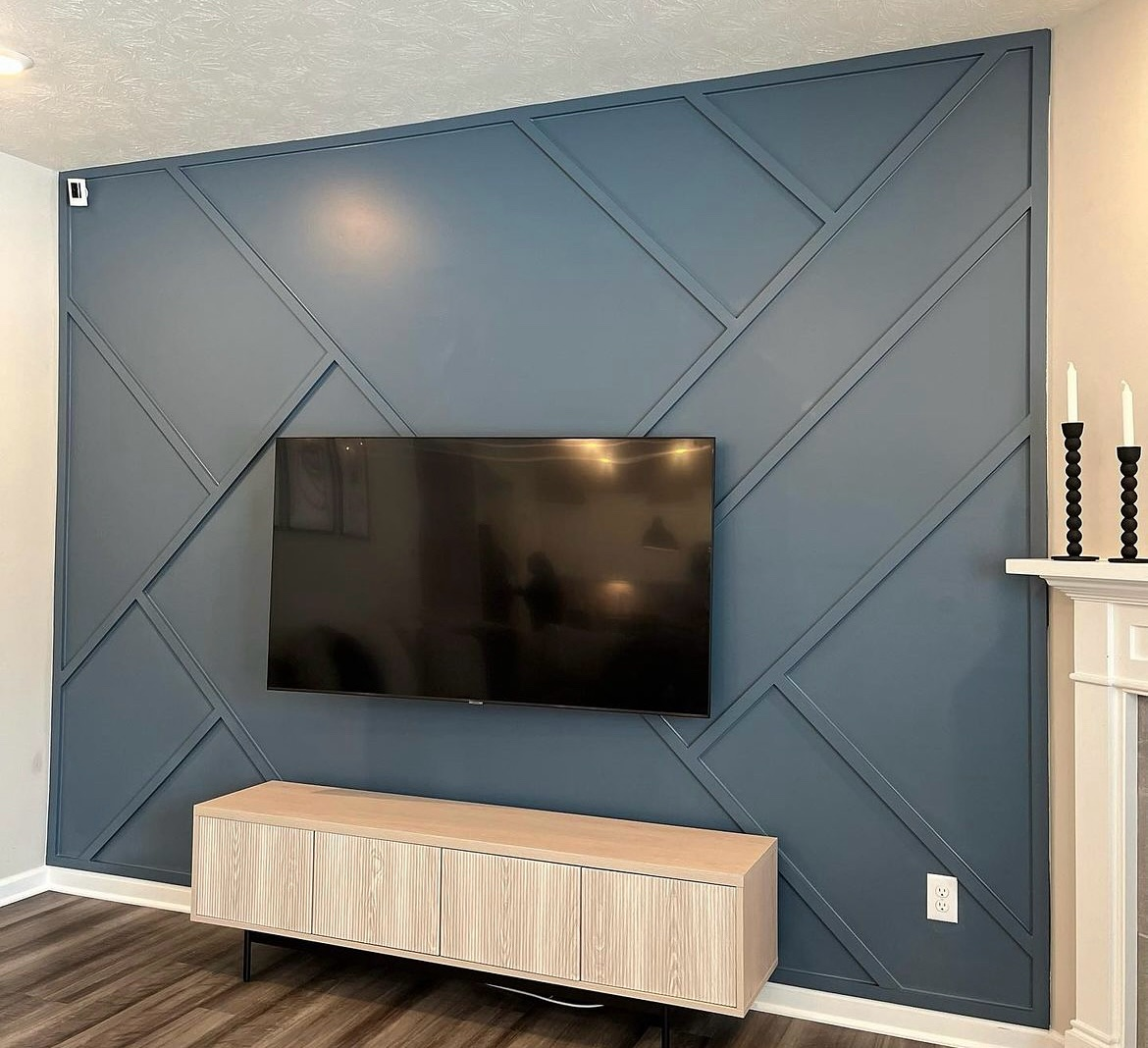Your Westfield loft deserves more than a big blank rectangle. Walk into any bonus room above the garage in communities like Harvest Trail, Belle Crest, or Bonterra, and you’ll find generous square footage with soaring ceilings but walls that feel unfinished. Builders like M/I Homes, David Weekley, Drees, Pulte, Beazer, Arbor, and Epcon create these flexible spaces to handle everything from game rooms to teen retreats, yet they rarely include the wall treatments that make them feel intentional.
The challenge isn’t just empty walls, it’s getting the proportions right. A 75-85 inch TV mounted on a plain drywall expanse looks lost, while sectional seating arranged around nothing creates awkward sightlines. Smart accent walls solve both problems by creating visual weight that anchors furniture placement while framing technology integration. These ten pre-measured layouts work specifically with common Westfield bonus room dimensions, ensuring your accent wall complements rather than competes with the room’s function.
From geometric patterns that add architectural interest to board-and-batten treatments that ground tall walls, these accent wall approaches transform builder-grade lofts into custom-feeling spaces that families actually want to spend time in. Each layout considers TV placement, seating arrangements, and the unique ceiling heights found in Westfield’s most popular floor plans.
Panel Sizing Behind Sectional Plus 75–85″ TV Placement
Getting panel proportions right determines whether your accent wall feels intentional or awkward. Most Westfield bonus rooms feature walls stretching 12–16 feet wide with 9–10 foot ceilings—dimensions that can swallow standard furniture if the wall treatment isn’t scaled properly. The key lies in creating panels that frame both your seating arrangement and TV placement as a unified composition.
For sectional sofas typical in M/I or Pulte bonus rooms, accent panels work best when sized to extend beyond the furniture footprint. If your sectional spans 10 feet, your accent wall treatment should stretch at least 12 feet wide to create visual balance. The height should reach 7–8 feet up the wall, leaving space above for crown molding or ceiling detail without overwhelming the room’s proportions.
TV placement within the panel system requires careful planning. A 75-85 inch screen needs roughly 6–7 feet of width and 4 feet of height for proper viewing. Creating a grid system with the TV centered in one larger panel, flanked by smaller accent panels, gives the screen context while maintaining the wall’s architectural rhythm. David Weekley and Drees bonus rooms with this treatment feel curated rather than furnished.
The spacing between panels matters as much as their size. Leaving 4–6 inches between panel frames creates shadow lines that add depth, while too-narrow spacing can make the wall feel cluttered. When panels are proportioned correctly to both furniture and TV placement, the entire room gains a focal point that guides traffic flow and furniture arrangement naturally.
When to Use 45-Degree Geometry vs Box Molding Systems
Geometric accent walls create visual interest through line and shadow, but choosing between angled and straight-line approaches depends on your room’s architecture and intended use. Westfield bonus rooms with sloped ceilings or interesting rooflines often benefit from 45-degree geometric patterns that echo the existing angles, while spaces with standard flat ceilings work better with traditional box molding grids.
45-degree diamond or chevron patterns add movement and energy that works well in active spaces—game rooms, teen hangouts, or media rooms where the wall treatment can handle bold personality. These angled designs photograph beautifully for social media but require precise installation to avoid looking crooked. Beazer and Arbor bonus rooms with contemporary architecture suit this approach, especially when painted in contrasting colors that highlight the geometric rhythm.
Box molding systems offer more flexibility for integrating technology and storage. Rectangular panels can incorporate recessed lighting, built-in speakers, or even hidden storage compartments behind hinged panels. This approach works especially well in Epcon or Pulte bonus rooms where the space serves multiple functions—homework area by day, entertainment room by evening. The grid creates organized zones that can be lit or furnished separately.
Consider maintenance when choosing between approaches. Box molding systems clean easily and show less dust accumulation in their straight-line channels. Geometric patterns with multiple angles catch dust and require more frequent attention. For busy families in Westfield, the classic box approach often proves more practical while still delivering custom architectural detail that transforms blank walls into intentional design elements.
Paint Sheen Selection: Flat vs Satin vs Semi-Gloss Applications
Paint sheen dramatically affects how accent wall details read in different lighting conditions. Westfield bonus rooms typically feature multiple light sources, natural light from dormer windows, recessed ceiling fixtures, and table lamps so choosing the right sheen prevents your carefully crafted panels from looking flat or overly shiny depending on time of day.
Flat paint works beautifully for creating subtle shadow effects in geometric or box molding systems. The lack of reflectivity allows the physical depth of trim work to create natural shadows without competing reflections. This approach suits David Weekley or Drees bonus rooms where the accent wall serves as a quiet backdrop for family activities. Flat paint also hides minor imperfections in trim installation, making it forgiving for DIY approaches.
Satin finishes offer the best balance for most Westfield families. The slight sheen adds richness without looking glossy, while providing enough durability for high-traffic bonus rooms. Satin paint cleans easily when kids leave fingerprints or when pets brush against walls. M/I and Pulte bonus rooms benefit from satin finishes that maintain their appearance through years of family use while still showcasing trim details effectively.
Semi-gloss paint should be reserved for trim elements rather than wall fields. Using semi-gloss on the actual molding while keeping wall areas in flat or satin creates definition between elements. This approach works especially well in Arbor or Beazer bonus rooms where white or light-colored trim contrasts against deeper wall tones. The sheen difference helps define each component while maintaining visual cohesion across the entire accent wall treatment.
Corner Treatment Solutions for L-Shaped Bonus Rooms
Many Westfield builders create L-shaped bonus rooms that wrap around stairwells or follow rooflines, presenting unique challenges for accent wall placement. These irregular spaces need wall treatments that work around corners while maintaining visual flow. Smart corner solutions turn awkward angles into architectural assets rather than design obstacles.
Inside corners where walls meet require different approaches than standard flat wall treatments. Box molding systems can wrap corners by continuing the grid pattern around the angle, but panel proportions need adjustment to maintain proper spacing. David Weekley bonus rooms with bay window areas benefit from this wrapped approach, creating unified treatment that makes the entire space feel cohesive rather than chopped up by architectural elements.
Outside corners present opportunities for dramatic focal points. Creating a feature corner with contrasting paint or extended trim work can anchor furniture placement while giving the L-shaped room a clear hierarchy. Drees and Pulte bonus rooms often have these prominent corners that work beautifully as media centers or reading nooks when highlighted with intentional wall treatment.
Transition strategies between treated and untreated walls prevent accent walls from looking like afterthoughts. Carrying trim elements partway down adjacent walls creates visual bridges, while coordinated paint colors tie the space together. The goal is making the accent wall feel like part of the room’s original architecture rather than something added later to solve a blank wall problem.
Lighting Integration Within Panel Systems
Accent walls become dramatically more effective when lighting integration is planned from the start. Westfield bonus rooms typically rely on overhead recessed lighting that creates even illumination but lacks the drama needed to showcase wall treatments properly. Built-in lighting within panel systems adds layers of illumination that transform the space from functional to atmospheric.
LED strip lighting concealed behind trim molding creates gentle wash effects that highlight panel depth without visible fixtures. This approach works especially well in M/I or Beazer bonus rooms where the accent wall doubles as a media wall, the subtle uplighting reduces eye strain during TV viewing while maintaining architectural interest. Color-changing LED strips allow seasonal or mood adjustments without changing the actual wall treatment.
Recessed accent lighting within individual panels creates focused illumination perfect for highlighting artwork or architectural details. Pulte and Epcon bonus rooms with built-in display areas benefit from this targeted approach. Small recessed fixtures installed during the trim construction phase provide professional-looking results without visible wiring or fixtures that compete with the wall design.
Picture lighting mounted on trim faces offers adjustable illumination that adapts to changing displays. This solution works well for families who rotate seasonal decorations or children’s artwork. Drees and Arbor bonus rooms with this flexibility maintain fresh appearance throughout the year while showcasing the accent wall architecture. The key is planning electrical rough-in during trim installation rather than trying to add lighting later.
Storage Integration Behind Decorative Panels
Smart accent walls do double duty by incorporating hidden storage behind decorative elements. Westfield families need places for game equipment, seasonal decorations, and media components that don’t detract from bonus room aesthetics. Properly planned panel systems can conceal substantial storage while maintaining clean architectural lines.
Hinged panels within box molding systems create concealed compartments perfect for board games, DVDs, or electronics that need occasional access but shouldn’t be visible daily. David Weekley and Drees bonus rooms benefit from these hidden storage solutions that keep the space looking organized even with active family use. Soft-close hinges prevent slamming while maintaining the illusion of solid decorative panels.
Built-in entertainment centers integrated into accent wall designs house media components while keeping wiring concealed. Rather than standalone furniture that fights the wall treatment, custom built-ins become part of the architectural composition. M/I and Pulte bonus rooms with these integrated solutions feel more finished and function better for modern entertainment needs including gaming systems, sound bars, and streaming devices.
Overhead storage above eye level utilizes bonus room height while maintaining visual cleanliness. Panels that extend to the ceiling can include access doors for storing seasonal items or bulky equipment that’s used infrequently. Beazer and Arbor bonus rooms often have this vertical space available, and proper storage integration prevents these areas from becoming cluttered or feeling wasted.
Color Psychology for Different Bonus Room Functions
Westfield bonus rooms serve multiple purposes. Homework spaces, game rooms, movie theaters, teen retreats and accent wall colors should support these varied functions. Understanding color psychology helps create walls that actually improve how the space feels and functions for different family activities.
Warm neutrals like soft grays, greiges, and warm whites work well for multipurpose bonus rooms that need to adapt to different moods and uses. These colors provide backdrop that doesn’t compete with changing decorations or seasonal displays. Pulte and Epcon bonus rooms with this approach remain fresh-looking through years of evolving family needs while still providing the visual weight needed to anchor furniture arrangements.
Bold accent colors can energize game rooms and teen spaces when used strategically. Deep blues, rich greens, or sophisticated burgundy create cozy, intimate feelings perfect for movie watching or gaming. David Weekley and Drees bonus rooms with these deeper tones feel more intentional and less like leftover space. The key is using bold color on the accent wall while keeping other walls neutral for balance.
Consider the room’s natural light when selecting colors. North-facing Westfield bonus rooms receive cooler light and benefit from warmer paint tones that add coziness. South-facing spaces get stronger light that can handle cooler colors without feeling stark. M/I and Beazer bonus rooms often have specific window orientations that should influence color choices for optimal appearance throughout the day.
Scale Considerations for 9-Foot vs 10-Foot Ceilings
Westfield builders typically install 9-foot ceilings in bonus rooms for cost efficiency, though some premium plans feature 10-foot heights. These different ceiling heights require adjusted panel proportions to maintain proper architectural relationships. Wrong-sized panels can make rooms feel either cramped or cavernous.
9-foot ceilings need panel systems that don’t overwhelm the vertical space. Box molding grids work best when panels are sized horizontally rather than as tall rectangles. Keeping individual panels around 24-30 inches wide by 18-24 inches tall maintains human scale while providing enough visual interest. David Weekley and M/I bonus rooms with standard ceiling heights benefit from these proportional relationships.
10-foot ceilings offer more flexibility for taller panel systems that can handle larger TVs and more dramatic architectural statements. Vertical panels reaching 36-42 inches tall create elegant proportions that take advantage of the extra height. Drees and Pulte premium bonus rooms with higher ceilings can support these larger-scale treatments without feeling overwhelming.
Crown molding selection must coordinate with ceiling height and panel proportions. Standard 3-4 inch crown profiles work well with 9-foot ceilings, while 10-foot spaces can handle 5-6 inch profiles that provide proper visual weight. Arbor and Beazer bonus rooms achieve the most polished appearance when all trim elements are scaled appropriately to the room’s actual dimensions rather than using one-size-fits-all approaches.
Maintenance and Durability for High-Traffic Spaces
Westfield bonus rooms see heavy family use, especially during Indiana winters when outdoor activities are limited. Accent wall treatments must withstand daily wear while maintaining their appearance through years of active use. Smart material choices and construction details prevent common problems before they start.
Paint quality matters more in bonus rooms than in formal spaces. Using premium paint with built-in primer creates durable surfaces that resist scuffs and clean easily. Semi-gloss finish on trim elements prevents damage from vacuuming and general handling. M/I and Pulte families find that investing in quality paint during initial installation saves money on touch-ups and repainting over time.
Trim material selection affects long-term durability. MDF (medium-density fiberboard) provides smooth surfaces perfect for painting but can show damage if moisture is present. Solid wood trim costs more initially but handles impacts better and can be sanded and refinished if damage occurs. David Weekley and Drees bonus rooms benefit from solid wood trim in high-impact areas like lower wall sections.
Installation details prevent common failure points. Proper fastening prevents trim from loosening over time, while quality caulking at joints prevents gaps from opening. Professional installation ensures that panels remain tight and aligned even as the house settles. These details matter more in bonus rooms than in formal spaces because the rooms receive heavier use and problems become obvious quickly.
Smart Technology Integration Planning
Modern Westfield families expect bonus rooms to handle current and future technology needs. Accent wall planning should anticipate wiring for sound systems, smart home controls, and entertainment equipment that continues to evolve. Smart integration prevents technology from competing with architectural details.
Pre-wiring during accent wall construction accommodates current needs while allowing future upgrades. Running conduit behind panels provides pathways for adding cables without damaging finished surfaces. Epcon and Beazer bonus rooms with this forethought adapt easily to changing technology without requiring wall modifications that compromise the decorative treatment.
Outlet placement within panel systems keeps charging stations and equipment connections accessible but visually organized. Recessed outlets within trim details maintain clean lines while providing necessary functionality. Drees and Arbor families appreciate these integrated solutions that prevent extension cords and power strips from cluttering the space.
Smart home integration works best when planned comprehensively. Accent walls can incorporate sensors, smart switches, and control panels within the decorative framework. M/I and Pulte bonus rooms with integrated smart controls feel more sophisticated while maintaining the architectural integrity of the accent wall treatment. The key is making technology feel like part of the design rather than an afterthought.
Why These Layouts Work in Westfield Homes
Westfield builders excel at creating generous bonus room spaces with good natural light and flexible layouts. However, these practical strengths can also create design challenges—rooms that feel unfinished despite quality construction. Strategic accent walls address these issues by adding architectural weight and visual focus that makes these spaces feel intentional rather than leftover.
The ten layout approaches outlined here work specifically with Westfield floor plans because they account for the ceiling heights, room proportions, and family lifestyles common in the area. Whether dealing with M/I’s efficient layouts, David Weekley’s custom touches, or Drees’ traditional proportions, these accent wall strategies adapt to existing architecture while adding the custom details that make homes feel special.
Most importantly, these treatments grow with families rather than becoming outdated as children age or needs change. Neutral backgrounds with quality trim work provide lasting architectural interest, while flexible storage and technology integration adapt to evolving requirements. Westfield families get accent walls that look custom while functioning practically for real family life.
Ready to Transform Your Westfield Bonus Room?
At Radford Woodworks, we specialize in accent walls that work with Westfield’s most popular floor plans from M/I Homes, David Weekley, Drees, Pulte, Beazer, Arbor, and Epcon. Our experience with local builder specifications ensures your accent wall integrates perfectly with existing architecture while adding the custom touches your family deserves.
Ready to see how these accent wall layouts can transform your bonus room? Call (317) 739-8555 or fill out our form to get a personalized quote for your specific space at radfordwoodworks.com/contact.
Your Westfield loft has the space. Now let’s give it the style to match.






